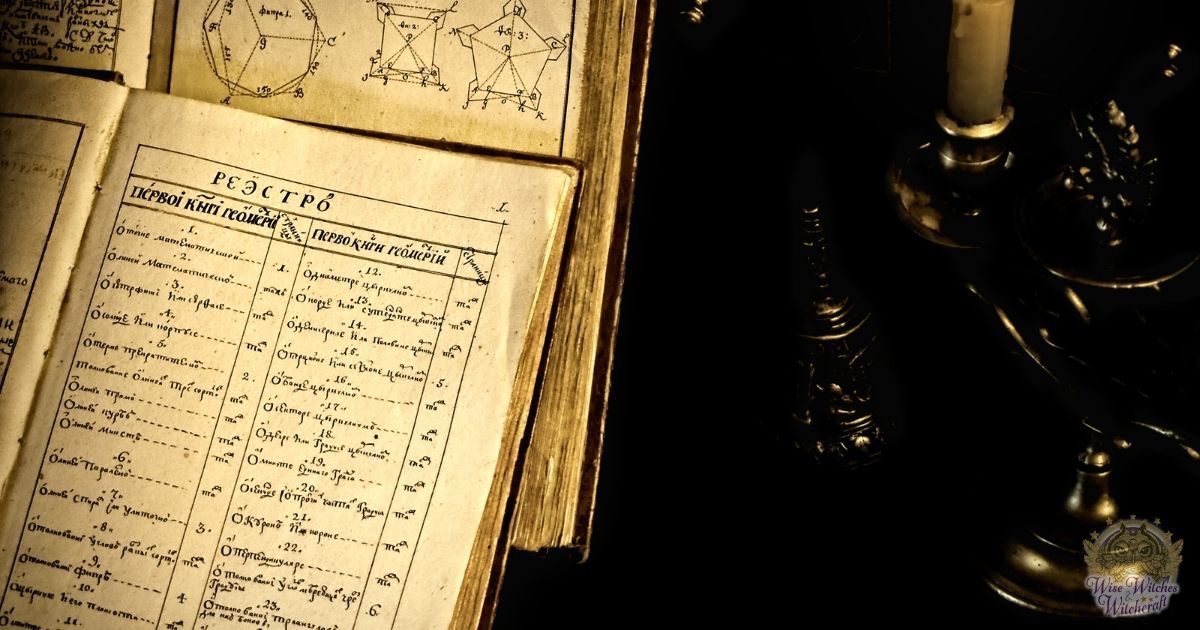Witchcraft Terms and Tools – Grimoire

A grimoire is essentially a textbook of magic, typically giving instructions for invoking angels or demons, performing divinations and gaining magical powers. They often contain astrological correspondences, lists of angels and demons, directions on casting charms and spells, mixing medicines, summoning unearthly entities, and making talismans. Books of this nature circulated widely throughout Europe in the Middle Ages and beyond, often kept hidden to prevent them from being burned by the persecutions of the Christian church.

The first grimoires appeared in the High Middle Ages (13th Century), growing out of earlier traditions (notably of medieval Jewish mysticism) which themselves continued traditions dating back to Late Antiquity.
Among the more notable grimoires are:
- “Picatrix” (or “The Aim of the Sage or “Ghayat al-Hakim fi’l-sihr”, 13th Century, from a 10th or 11th Century Arabic original handbook of talismanic magic);
- “The Sworn Book of Honorius” (or “Liber Juratus”, 13th Century, describing angelic powers and seals, and including instructions on how to conjure and command demons);
- “Sefer Raziel Ha-Malakh” (or “Liber Razielis Archangeli”, 13th Century, a medieval Kabbalistic grimoire, primarily written in Hebrew and Aramaic);
- “The Book of the Sacred Magic of Abramelin the Mage” (or “The Book of Abramelin”, 15th Century, detailing Abramelin’s revelation of his magical and Kabbalistic secrets to his son, Lamech);
- “The Munich Handbook” (or “The Munich Manual of Demonic Magic”, 15th Century, a Latin text largely concerned with demonology and necromancy);
- “Libri tres de occulta philosophia” (or “Three Books about Occult Philosophy”, 16th Century, Cornelius Agrippa’s 1531 treatise on elemental, celestial and intellectual magic);
- “The Greater Key of Solomon” (or “The Key of Solomon” or “Clavis Salomonis”, 16th Century, a medieval book on magic, conjurations and rituals attributed to King Solomon);
- “The Lesser Key of Solomon” (or “Lemegeton” or “Clavicula Salomonis”, 17th Century, one of the most popular books of demonology);
- “Pseudomonarchia Daemonum” (or “The Hierarchy of Demons” or “The False Kingdom of Demons”, 16th Century, a list by Johann Weyer of demons and the appropriate hours and rituals to conjure them, published in 1577);
- “Arbatel de Magia Veterum” (or “Arbatel of the Magic of the Ancients”, 16th Century, a treatise on ceremonial magic, written in Latin and first published in 1575 in Basel, Switzerland);
- “Semiphoras and Shemhamphoras” (or “Semiphoras und Shemhamphoras Salominis”, 17th Century, a grimoire attributed to King Solomon, first published in1686 but possibly of late medieval origin);
- “Grimorium Verum” (or “The Grimoire of Truth”, 18th Century, a book on magic which purports to have been written in 1517 and which also claims origin from King Solomon);
- “The Black Pullet” (18th Century, covering the ancient science of magical talismans and rings and the art of necromancy and Kabbalah);
- “The Great Book of Saint Cyprian” (or “O Antigo Livro de São Cipriano: Capa de Aço”, 19th century, a book on magic and the occult written in Portuguese and Spanish);
- “Dogme et Rituel de la Haute Magie” (or “Dogma and Ritual of High Magic”, 19th Century, Eliphas Lévi‘s first published treatise on ritual magic, which appeared in 1855);
- “The Grand Grimoire” (or “Le Grand Grimoire”, 19th Century, although claiming to date from 1522, instructions to summon Lucifer or Lucifuge Rofocale for the purpose of forming a pact);
- “Sixth and Seventh Books of Moses” (19th Century, two grimoires allegedly dictated to Moses along with the Torah, including magical spells used to summon spirits);
- “The Sword of Moses” (19th Century, an apocryphal Hebrew book of magic, edited by Moses Gaster in 1896 from a 13th or 14th Century manuscript);
- “The Book of the Goetia of Solomon the King” (20th Century, a 1904 book on magic by Aleister Crowley and S. L. MacGregor Mathers, including a translation of the “Ars Goetia” section of “The Lesser Key of Solomon”);


The so-called Voynich Manuscript (a mysterious illustrated book written in an indecipherable text) has never been deciphered, and is difficult to date, but may also qualify as a 15th Century grimoire. A well-known modern fictional grimoire is the “Necronomicon”, as described in the novels and stories of the 20th Century horror and occult author, H. P. Lovecraft, which was inspired by Sumerian mythology and the “Ars Goetia” section in the “Lesser Key of Solomon” concerning the summoning of demons. The Book of Shadows kept by modern Wiccans and Neopagans after Gerald Gardner can be considered a kind of grimoire. A. E. Waite’s 1913 “Book of Ceremonial Magic” (originally called “The Book of Black Magic and of Pacts”) is an attempt to synthesize many famous grimoires into one system.




